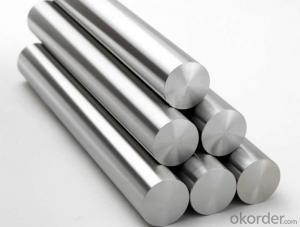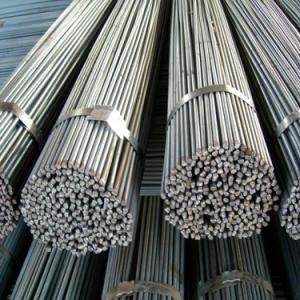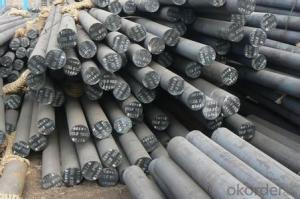High Quality Round Bar 5-28mm Hot Rolled GB Q235 Q195
- Loading Port:
- China Main Port
- Payment Terms:
- TT or LC
- Min Order Qty:
- 25 m.t.
- Supply Capability:
- 100000 m.t./month
OKorder Service Pledge
OKorder Financial Service
You Might Also Like
Product Applications:
1) Suitable for making various strong cutting tool abrasion resistance, impact resistance.
2) Used to produce all kinds of high hard and super hard saw blade, drill, tap, broach, gear hob and various kinds of milling cutter.
3) Used for advanced punching die, screw die, and the toughness and complicated shape of the punch, etc.
4) Is used for cold forging die and drawing mode, etc.
5) Recommended watchcase factory, screw factory and other cold stamping products industry use.
Product Advantages:
OKorder's High Quality Round Bar 5-28mm Hot Rolled GB Q235 Q195are durable, strong, and resist corrosion.
Main Product Features:
· Premium quality
· Prompt delivery & seaworthy packing (30 days after receiving deposit)
· Corrosion resistance
· Can be recycled and reused
· Mill test certification
· Professional Service
· Competitive pricing
Product Specifications:
1. Grade: GB, JIS, ASTM, EN
2. Grade: Q235, SS400, A36, S235JR
3. Diameter and mass: As below
Diameter | Mass | Diameter | Mass | Diameter | Mass |
(mm) | (kg/m) | (mm) | (kg/m) | (mm) | (kg/m) |
6 | 0.22 | 22 | 2.98 | 53 | 17.30 |
7 | 0.30 | 24 | 3.55 | 56 | 19.30 |
8 | 0.40 | 25 | 3.85 | 60 | 22.20 |
9 | 0.50 | 26 | 4.17 | 63 | 24.50 |
10 | 0.62 | 28 | 4.83 | 65 | 26.00 |
11 | 0.75 | 30 | 5.55 | 70 | 30.20 |
12 | 0.89 | 32 | 6.31 | 75 | 34.70 |
13 | 1.04 | 34 | 7.13 | 80 | 39.50 |
14 | 1.21 | 36 | 7.99 | 85 | 44.50 |
15 | 1.39 | 38 | 8.90 | 90 | 49.90 |
16 | 1.58 | 40 | 9.86 | 95 | 55.60 |
17 | 1.78 | 42 | 10.90 | 100 | 61.70 |
18 | 2.00 | 45 | 12.50 | 120 | 88.85 |
19 | 2.23 | 48 | 14.20 | 140 | 120.93 |
20 | 2.47 | 50 | 15.40 | 150 | 138.82 |
4. Material: Mild Steel
5. Heat treatment of high quality steel:
Fire: Isothermal annealing temperature is 800 ~ 880 °C, with 10 ~ 20 °C, the furnace cooling to about 600 °C, hardness above HB269.
Preheat temperature: 730-730 °C
Quenching temperature: 1190-1210 °C
Tempering temperature: 540-595 °C
Cold drawn, hardness 285 HBS
Cold drawn after annealing condition, hardness 277 HBS
Quenching methods: oil quenching, air cooling or salt bath quenching
FAQ:
Q1: Why buy Materials & Equipment from OKorder.com?
A1: All products offered byOKorder.com are carefully selected from China's most reliable manufacturing enterprises. Through its ISO certifications, OKorder.com adheres to the highest standards and a commitment to supply chain safety and customer satisfaction.
Q2: How do we guarantee the quality of our products?
A2: We have established an advanced quality management system which conducts strict quality tests at every step, from raw materials to the final product. At the same time, we provide extensive follow-up service assurances as required.
Q3: How soon can we receive the product after purchase?
A3: Within three days of placing an order, we will begin production. The specific shipping date is dependent upon international and government factors, but is typically 7 to 10 workdays.
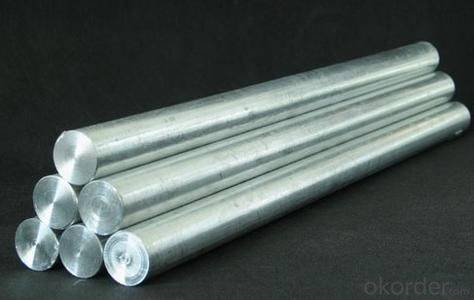
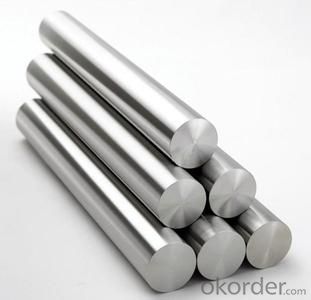
- Q:Can steel round bars be used in the production of power tools?
- Yes, steel round bars can be used in the production of power tools. Steel is a durable and strong material that is commonly used in the manufacturing of various tools and machinery, including power tools. Steel round bars can be used to create the body, handles, and other components of power tools, providing stability, strength, and longevity. The steel used in power tools is often selected for its high tensile strength and resistance to wear and tear. Additionally, steel can be easily machined, allowing for precise shaping and customization of power tool components. Overall, steel round bars are a suitable choice for the production of power tools due to their strength, durability, and versatility.
- Q:What are the tolerance levels for steel round bars?
- The tolerance levels for steel round bars can vary depending on the specific requirements and industry standards. Generally, the tolerance levels for diameter can range from +/- 0.001 inches to +/- 0.005 inches, while the tolerance levels for length can range from +/- 0.125 inches to +/- 0.250 inches. It is important to refer to the relevant specifications or consult with a manufacturer to determine the specific tolerance levels for a particular steel round bar.
- Q:What is the difference between hot rolled and cold drawn steel round bars?
- Hot rolled steel round bars undergo the process of heating a steel billet or ingot at a high temperature and subsequently rolling it into the desired shape. This process yields a rougher surface finish and a greater diameter tolerance in comparison to cold drawn steel round bars. The usage of hot rolled bars is frequently found in areas where strength and durability hold significance, such as in construction and manufacturing. On the contrary, cold drawn steel round bars are created by pulling a hot rolled bar through a die at room temperature, leading to a smoother surface finish and tighter diameter tolerances. This procedure also enhances the mechanical properties of the steel, including its strength and hardness. Cold drawn bars are often employed in scenarios where precision and a high-quality surface finish are prerequisites, like in the production of shafts, bolts, and precision components. To summarize, the principal disparities between hot rolled and cold drawn steel round bars encompass the surface finish, diameter tolerance, and mechanical properties. Hot rolled bars bear a rougher surface finish, larger diameter tolerances, and are typically utilized in contexts where strength and durability are paramount. Cold drawn bars possess a smoother surface finish, tighter diameter tolerances, and are commonly employed in situations necessitating precision and a high-quality surface finish.
- Q:What are the different methods used for machining steel round bars?
- There are several methods used for machining steel round bars, each with its own advantages and applications. Some of the commonly used methods include: 1. Turning: This is a widely used method that involves rotating the steel round bar against a cutting tool, which removes material and creates the desired shape. Turning is suitable for both external and internal operations and can achieve high precision and surface finish. 2. Milling: In milling, a rotating multi-tooth cutter removes material from the steel round bar to create flat or contoured surfaces. This method is versatile and can be used for various operations, including face milling, slotting, and profiling. 3. Drilling: Drilling involves creating holes in the steel round bar using a rotating drill bit. This method is commonly used for creating holes of different sizes and depths, and can be done manually or through automated processes. 4. Grinding: Grinding is a precision machining method that uses abrasives to remove material from the steel round bar. It is commonly used to achieve a smooth surface finish, tight tolerances, and precise dimensions. Grinding can be performed using various types of grinding machines, such as cylindrical grinders or surface grinders. 5. Boring: Boring is used to enlarge existing holes or create internal cylindrical shapes in the steel round bar. It involves rotating a cutting tool inside the bar to remove material and achieve the desired dimensions and surface finish. 6. Broaching: Broaching is a specialized machining method used to create complex internal or external shapes in the steel round bar. It involves using a broach, a multi-toothed cutting tool, that is pushed or pulled through the bar to remove material and create the desired shape. 7. Sawing: Sawing is a method used to cut the steel round bar into desired lengths or shapes using a rotating blade with teeth. This method is efficient for mass production and can be performed using manual or automated sawing machines. These are just a few of the methods used for machining steel round bars. The choice of method depends on factors such as the desired shape, dimensions, tolerances, and surface finish, as well as the production volume and available equipment.
- Q:Can steel round bars be used for making sway bars?
- Certainly! Sway bars can indeed be crafted using steel round bars. These bars, also recognized as stabilizer bars or anti-roll bars, are implemented in automobiles to diminish body roll and enhance stability while maneuvering corners. The utilization of steel round bars is quite prevalent for this task owing to their remarkable robustness and endurance. The circular form facilitates the uniform dispersion of forces and furnishes crucial torsional stiffness necessary for sway bars to effectively govern body roll. Furthermore, steel is effortlessly obtainable, economical, and can be conveniently shaped and sized to cater to sway bar requirements.
- Q:Are steel round bars suitable for use in the construction industry?
- Yes, steel round bars are commonly used in the construction industry due to their strength, durability, and versatility. They provide structural support in various applications such as reinforcement in concrete, framing, and the creation of beams and columns. Additionally, steel round bars can be easily fabricated, welded, and formed into different shapes, making them a suitable choice for a wide range of construction projects.
- Q:What are the different grades of carbon steel round bars for structural applications?
- Carbon steel round bars for structural applications are available in a variety of grades, each with its own unique properties and characteristics. Some of the common grades include: 1. ASTM A36: This is one of the most widely used grades of carbon steel round bars for structural applications. It offers excellent weldability and machinability, making it suitable for a wide range of structural projects. 2. ASTM A572-50: This grade is a high-strength, low-alloy structural steel that offers improved strength-to-weight ratio compared to traditional carbon steel. It is commonly used in construction and structural applications where high strength is required. 3. ASTM A588: This grade is a high-strength, low-alloy structural steel that is primarily used in applications where corrosion resistance is needed. It offers excellent atmospheric corrosion resistance and is often used in outdoor structures such as bridges and buildings. 4. ASTM A709: This grade is a high-strength, low-alloy structural steel that is commonly used in bridge construction. It offers excellent strength, weldability, and toughness, making it suitable for demanding structural applications. 5. ASTM A105: This grade is a low-carbon steel with good strength and impact resistance. It is commonly used in applications where high strength and ductility are required, such as in the construction of heavy equipment and machinery. These are just a few examples of the different grades of carbon steel round bars available for structural applications. The choice of grade depends on factors such as desired strength, weldability, machinability, and corrosion resistance. It is important to consult with a steel supplier or engineer to determine the most appropriate grade for a specific application.
- Q:Can steel round bars be used for making tie rods?
- Indeed, tie rods can be fashioned from steel round bars. Owing to their robustness and endurance, steel round bars find widespread usage in the realm of construction and engineering. By offering structural reinforcement and stability, tie rods serve a vital purpose, and steel round bars are particularly appropriate for this task. Possessing remarkable tensile strength, they can withstand substantial loads and tension, rendering them a perfect selection for tie rods. Moreover, steel round bars enable effortless fabrication and welding, thereby allowing for adaptability and versatility in the creation and assembly of tie rods.
- Q:What are the different heat treatment methods for steel round bars?
- Steel round bars can undergo various heat treatment methods to enhance their mechanical properties and overall performance. These methods, namely annealing, normalizing, quenching, tempering, and case hardening, are commonly employed. 1. Annealing: By subjecting the steel round bars to a specific temperature and maintaining it for a certain duration, annealing achieves a uniform microstructure. This treatment alleviates internal stresses, improves ductility, and enhances machinability. 2. Normalizing: This technique involves heating the steel round bars slightly above their critical transformation temperature and subsequently cooling them in still air. Normalizing refines the grain structure, enhances mechanical properties, and improves resistance to impact and fatigue. 3. Quenching: The process of quenching entails heating the steel round bars above their critical temperature and rapidly cooling them by immersion in a quenching medium like oil, water, or brine. This rapid cooling hardens the steel, rendering it stronger and more resistant to wear and abrasion. However, quenched steel may exhibit brittleness, necessitating additional heat treatment steps. 4. Tempering: Following the quenching process, tempering is often employed to reduce brittleness and enhance toughness. Tempering involves reheating the quenched steel to a specific temperature and holding it there for a designated time, followed by gradual cooling. This procedure alleviates internal stresses, improves ductility, and enhances overall toughness and machinability. 5. Case Hardening: Case hardening is a surface heat treatment method that increases the hardness of the outer layer of steel round bars while maintaining a relatively softer core. This technique involves heating the steel in a carbon-rich environment, such as a gas or salt bath, and subsequently quenching it to achieve a hardened outer layer. Case hardening improves wear resistance and fatigue strength, making it suitable for applications requiring high surface hardness. It is crucial to note that the selection of the specific heat treatment method for steel round bars depends on the desired mechanical properties and intended application. Manufacturers meticulously choose the appropriate heat treatment method based on factors such as steel composition, desired hardness, and required strength.
- Q:Are steel round bars susceptible to cracking?
- Cracking in steel round bars can occur under certain circumstances. Factors that contribute to cracking include high stress levels, improper heat treatment, and the presence of impurities or defects in the material. Cracking is also more likely with sudden temperature changes or excessive loading. It is worth noting that the susceptibility to cracking varies depending on the grade and composition of the steel. Low carbon or mild steel is generally less prone to cracking compared to higher carbon or alloy steels. To prevent cracking, it is crucial to handle and store steel round bars properly. This includes avoiding dropping or mishandling the bars and storing them in a dry, controlled environment to prevent corrosion. Proper heat treatment processes, such as annealing or tempering, can improve the structural integrity of steel round bars and reduce the risk of cracking. Regular inspections and testing for defects or impurities can help identify and address issues before they lead to cracking. In conclusion, while steel round bars can be susceptible to cracking, taking appropriate precautions and using proper manufacturing and handling techniques can minimize the risk and ensure the bars' integrity.
1. Manufacturer Overview |
|
|---|---|
| Location | |
| Year Established | |
| Annual Output Value | |
| Main Markets | |
| Company Certifications | |
2. Manufacturer Certificates |
|
|---|---|
| a) Certification Name | |
| Range | |
| Reference | |
| Validity Period | |
3. Manufacturer Capability |
|
|---|---|
| a)Trade Capacity | |
| Nearest Port | |
| Export Percentage | |
| No.of Employees in Trade Department | |
| Language Spoken: | |
| b)Factory Information | |
| Factory Size: | |
| No. of Production Lines | |
| Contract Manufacturing | |
| Product Price Range | |
Send your message to us
High Quality Round Bar 5-28mm Hot Rolled GB Q235 Q195
- Loading Port:
- China Main Port
- Payment Terms:
- TT or LC
- Min Order Qty:
- 25 m.t.
- Supply Capability:
- 100000 m.t./month
OKorder Service Pledge
OKorder Financial Service
Similar products
New products
Hot products
Related keywords


